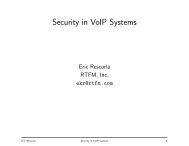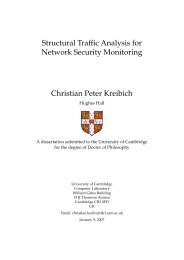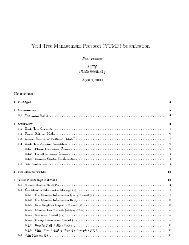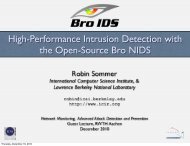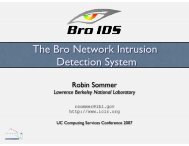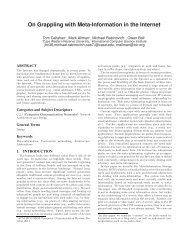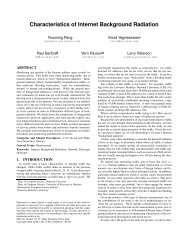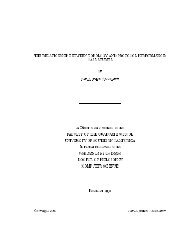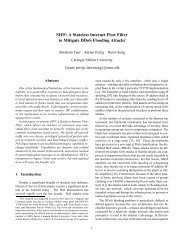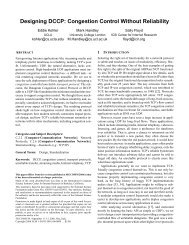Enhancing Byte-Level Network Intrusion Detection Signatures with ...
Enhancing Byte-Level Network Intrusion Detection Signatures with ...
Enhancing Byte-Level Network Intrusion Detection Signatures with ...
Create successful ePaper yourself
Turn your PDF publications into a flip-book with our unique Google optimized e-Paper software.
matcher [8, 12]. 1 On the other hand, regular expressions give us setwise<br />
matching for free: by using the union operator on the individual<br />
patterns, we get a new regular expression which effectively combines<br />
all of them. The result is a single DFA that again needs O(n)<br />
operations to match against an n byte sequence. Only slight modifications<br />
have been necessary to extend the interface of Bro’s alreadyexisting<br />
regular expression matcher to explicitly allow grouping of<br />
expressions.<br />
Given the expressiveness and efficiency of regular expressions,<br />
there is still a reason why a NIDS might avoid using them: the<br />
underlying DFA can grow very large. Fully compiling a regular expression<br />
into a DFA leads potentially to an exponential number of<br />
DFA states, depending on the particulars of the patterns [18]. Considering<br />
the very complex regular expression built by combining<br />
all individual patterns, this straight-forward approach could easily<br />
be intractable. Our experience <strong>with</strong> building DFAs for regular expressions<br />
matching many hundreds of signatures shows that this is<br />
indeed the case. However, it turns out that in practice it is possible<br />
to avoid the state/time explosion, as follows.<br />
Instead of pre-computing the DFA, we build the DFA “on-thefly”<br />
during the actual matching [17]. Each time the DFA needs to<br />
transit into a state that is not already constructed, we compute the<br />
new state and record it for future reuse. This way, we only store<br />
DFA states that are actually needed. An important observation is<br />
that for n new input characters, we will build at most n new states.<br />
Furthermore, we find in practice (§4.3) that for normal traffic the<br />
growth is much less than linear.<br />
However, there is still a concern that given inauspicious traffic—<br />
which may actually be artificially crafted by an attacker—the state<br />
construction may eventually consume more memory than we have<br />
available. Therefore, we also implemented a memory-bounded DFA<br />
state cache. Configured <strong>with</strong> a maximum number of DFA states,<br />
it expires old states on a least-recently-used basis. In the sequel,<br />
when we mention “Bro <strong>with</strong> a limited state cache,” we are referring<br />
to such a bounded set of states (which is a configuration option for<br />
our version of Bro), using the default bound of 10,000 states.<br />
Another important point is that it’s not necessary to combine all<br />
patterns contained in the signature set into a single regular expression.<br />
Most signatures contain additional constraints like IP address<br />
ranges or port numbers that restrict their applicability to a subset of<br />
the whole traffic. Based on these constraints, we can build groups<br />
of signatures that match the same kind of traffic. By collecting only<br />
those patterns into a common regular expression for matching the<br />
group, we are able to reduce the size of the resulting DFA drastically.<br />
As we show in §4, this gives us a very powerful pattern<br />
matcher still efficient enough to cope <strong>with</strong> high-volume traffic.<br />
3.2 Improving Alert Quality by Using Context<br />
Though pattern matching is a central part of any signature-based<br />
NIDSs, as we discussed above there is potentially great utility in<br />
incorporating more context in the system’s analysis prior to generating<br />
an alert, to ensure that there is indeed something alert-worthy<br />
occurring. We can considerably increase the quality of alerts, while<br />
simultaneously reducing their quantity, by utilizing knowledge<br />
about the current state of the network. Bro is an excellent tool for<br />
this as it already keeps a lot of easily accessible state.<br />
The new signature engine is designed to fit nicely into Bro’s layered<br />
architecture as an adjunct to the protocol analysis event engine<br />
(see Figure 1). We have implemented a custom language for<br />
defining signatures. It is mostly a superset of other, similar lan-<br />
1 The code of [12] is already contained in the Snort distribution, but<br />
not compiled-in by default. This is perhaps due to some subtle bugs,<br />
some of which we encountered during our testing as well.<br />
Figure 1: Integrating the signature engine (adapted from [25])<br />
<strong>Signatures</strong><br />
Policy script<br />
Event Control<br />
Packet filter<br />
Signature<br />
Engine<br />
Policy Layer<br />
Signature Control<br />
Event stream<br />
Event Engine<br />
Packet capture<br />
<strong>Network</strong><br />
Real−time notification<br />
Filtered packet stream<br />
Packet stream<br />
guages, and we describe it in more detail in §3.3. A new component<br />
placed <strong>with</strong>in Bro’s middle layer matches these signatures against<br />
the packet stream. Whenever it finds a match, it inserts a new event<br />
into the event stream. The policy layer can then decide how to react.<br />
Additionally, we can pass information from the policy layer<br />
back into the signature engine to control its operation. A signature<br />
can specify a script function to call whenever a particular signature<br />
matches. This function can then consult additional context and indicate<br />
whether the corresponding event should indeed be generated.<br />
We show an example of this later in §3.5.4.<br />
In general, Bro’s analyzers follow the communication between<br />
two endpoints and extract protocol-specific information. For example,<br />
the HTTP analyzer is able to extract URIs requested by Web<br />
clients (which includes performing general preprocessing such as<br />
expanding hex escapes) and the status code and items sent back<br />
by servers in reply, whereas the FTP analyzer follows the application<br />
dialog, matching FTP commands and arguments (such as the<br />
names of accessed files) <strong>with</strong> their corresponding replies. Clearly,<br />
this protocol-specific analysis provides significantly more context<br />
than does a simple view of the total payload as an undifferentiated<br />
byte stream.<br />
The signature engine can take advantage of this additional information<br />
by incorporating semantic-level signature matching. For<br />
example, the signatures can include the notion of matching against<br />
HTTP URIs; the URIs to be matched are provided by Bro’s HTTP<br />
analyzer. Having developed this mechanism for interfacing the signature<br />
engine <strong>with</strong> the HTTP analyzer, it is now straight forward<br />
to extend it to other analyzers and semantic elements (indeed, we<br />
timed how long it took to add and debug interfaces for FTP and<br />
Finger, and the two totalled only 20 minutes).<br />
Central to Bro’s architecture is its connection management. Each<br />
network packet is associated <strong>with</strong> exactly one connection. This notion<br />
of connections allows several powerful extensions to traditional<br />
signatures. First of all, Bro reassembles the payload stream of TCP<br />
connections. Therefore, we can perform all pattern matching on the<br />
actual stream (in contrast to individual packets). While Snort has a<br />
preprocessor for TCP session reassembling, it does so by combining<br />
several packets into a larger “virtual” packet. This packet is then<br />
passed on to the pattern matcher. Because the resulting analysis<br />
remains packet-based, it still suffers from discretization problems<br />
introduced by focusing on packets, such as missing byte sequences<br />
that cross packet boundaries. (See a related discussion in [25] of the<br />
problem of matching strings in TCP traffic in the face of possible<br />
intruder evasion [27].)<br />
In Bro, a signature match does not necessarily correspond to an<br />
alert; as <strong>with</strong> other events, that decision is left to the policy script.<br />
Hence, it makes sense to remember which signatures have matched<br />
for a particular connection so far. Given this information, it is then<br />
possible to specify dependencies between signatures like “signature




